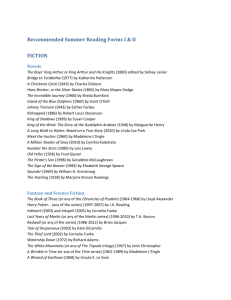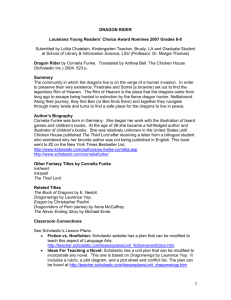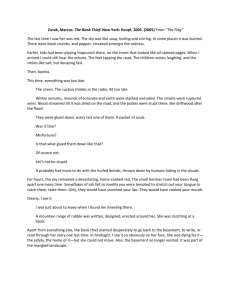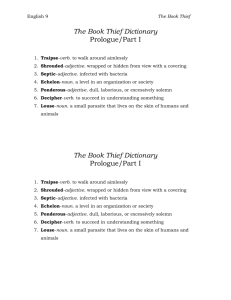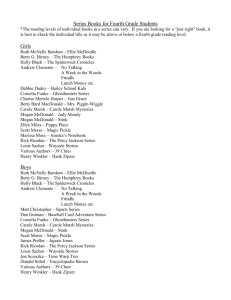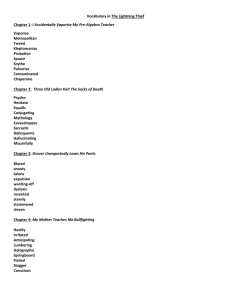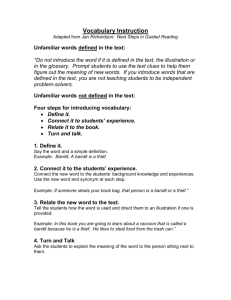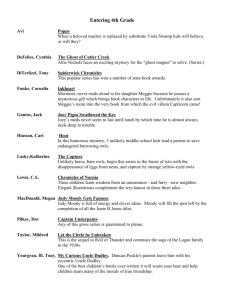Interview with Cornelia Funke
advertisement
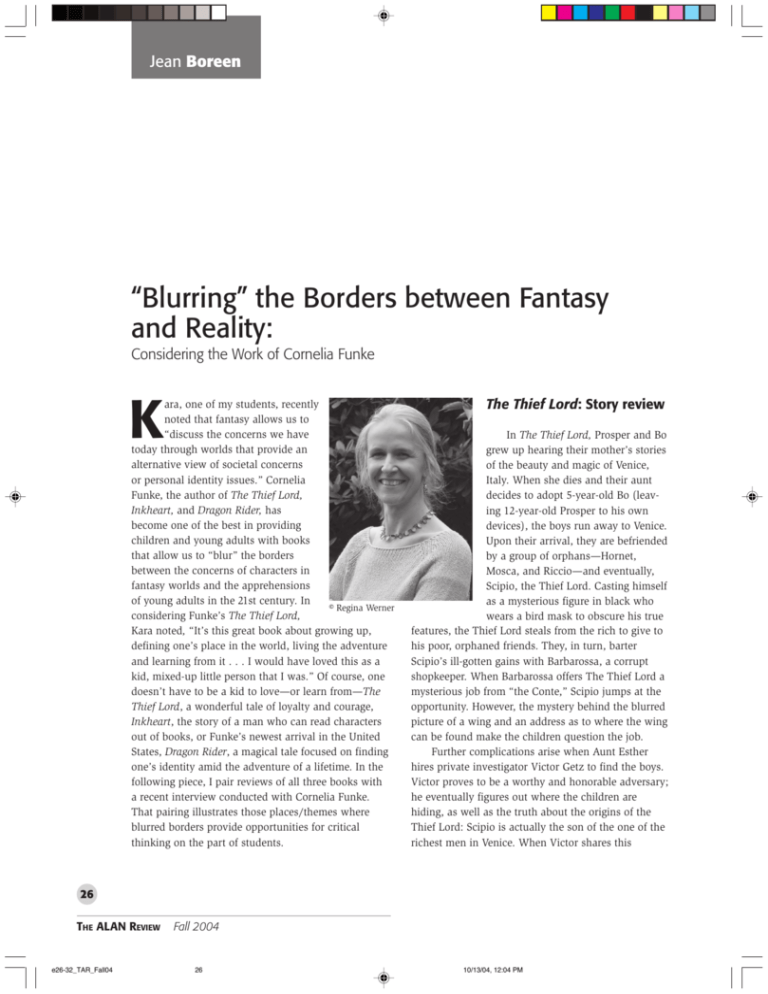
Jean Boreen “Blurring” the Borders between Fantasy and Reality: Considering the Work of Cornelia Funke K ara, one of my students, recently noted that fantasy allows us to “discuss the concerns we have today through worlds that provide an alternative view of societal concerns or personal identity issues.” Cornelia Funke, the author of The Thief Lord, Inkheart, and Dragon Rider, has become one of the best in providing children and young adults with books that allow us to “blur” the borders between the concerns of characters in fantasy worlds and the apprehensions of young adults in the 21st century. In © Regina Werner considering Funke’s The Thief Lord, Kara noted, “It’s this great book about growing up, defining one’s place in the world, living the adventure and learning from it . . . I would have loved this as a kid, mixed-up little person that I was.” Of course, one doesn’t have to be a kid to love—or learn from—The Thief Lord, a wonderful tale of loyalty and courage, Inkheart, the story of a man who can read characters out of books, or Funke’s newest arrival in the United States, Dragon Rider, a magical tale focused on finding one’s identity amid the adventure of a lifetime. In the following piece, I pair reviews of all three books with a recent interview conducted with Cornelia Funke. That pairing illustrates those places/themes where blurred borders provide opportunities for critical thinking on the part of students. The Thief Lord: Story review In The Thief Lord, Prosper and Bo grew up hearing their mother’s stories of the beauty and magic of Venice, Italy. When she dies and their aunt decides to adopt 5-year-old Bo (leaving 12-year-old Prosper to his own devices), the boys run away to Venice. Upon their arrival, they are befriended by a group of orphans—Hornet, Mosca, and Riccio—and eventually, Scipio, the Thief Lord. Casting himself as a mysterious figure in black who wears a bird mask to obscure his true features, the Thief Lord steals from the rich to give to his poor, orphaned friends. They, in turn, barter Scipio’s ill-gotten gains with Barbarossa, a corrupt shopkeeper. When Barbarossa offers The Thief Lord a mysterious job from “the Conte,” Scipio jumps at the opportunity. However, the mystery behind the blurred picture of a wing and an address as to where the wing can be found make the children question the job. Further complications arise when Aunt Esther hires private investigator Victor Getz to find the boys. Victor proves to be a worthy and honorable adversary; he eventually figures out where the children are hiding, as well as the truth about the origins of the Thief Lord: Scipio is actually the son of the one of the richest men in Venice. When Victor shares this 26 THE ALAN REVIEW e26-32_TAR_Fall04 Fall 2004 26 10/13/04, 12:04 PM information with Prosper and company, they reject Scipio and decide to support themselves by stealing the mysterious wing for the Conte. A short time later at the home of Signorina Ida Spavento, they are “found out,” befriended by the sensible Ida, and hear the true story of the wing. The wing is actually part of a magical merry-goround that allows the rider to become older or younger, depending upon how many rotations one takes on the ride. Scipio and Prosper are both fascinated by the idea that they could become instant adults, Scipio to escape the control of his father and Prosper to keep both himself and Bo safe from Aunt Esther. Once the opportunity presents itself, however, the decisions made by each young man have amazing consequences for their friends . . . and their enemies. Inkheart: Story review Funke’s second offering to the field of children’s and young adult fantasy, Inkheart, is the story of Meggie, her father, Mo, and the repercussions of Mo’s ability to read characters out of their novels. That ability has become a curse for Mo, for it has brought him to the attention of the villainous Capricorn (read out of a book called Inkheart) who plans to use Mo to bring more evil-doers as well as great riches from books like Treasure Island and The Arabian Nights. When the mysterious Dustfinger shows up at Mo and Meggie’s home to warn them that Capricorn knows where they are, Mo, who has never told Meggie about his strange ability, takes Meggie to the home of Aunt Elinor, an eccentric woman who loves books as much as Mo and Meggie. However, this is not the strangest of Mo’s decisions: he also brings a book along that Meggie has never before seen. This book, Inkheart, is a source of fascination for all for very different reasons, and when Elinor borrows the book from Mo without his knowledge and he is subsequently kidnapped by Capricorn’s men, she sets forth a chain of events that will impact them all. Meggie enlists Elinor and, grudgingly, Dustfinger, to help free her father. When she is eventually reunited with him, Meggie makes Mo tell her the real secret of Inkheart. Mo admits he has the ability to bring “things” out of books, but that he and Teresa, Meggie’s mother, had never worried about consequences, mainly because Teresa so loved to hear Mo read stories aloud and the small objects that appeared always made them happy. But one evening, as Mo was reading Inkheart, Teresa and two family cats disappeared at the exact moment Capricorn, Dusterfinger, and Capricorn’s henchman, Basta, appeared. Mo desperately attempted to bring Teresa back out of the book, but to no avail. In his despair, Mo decided there would be no more attempts to bring Teresa back because he was simply too frightened of what else might come out of the book. So he locked away his copy of Inkheart. However, Capricorn was not so easily put off; he sent his henchmen to collect all of the copies of the book in existence so he could control both his former and his current worlds. Capricorn also found another reader with Mo’s general abilities, but Darius did not have the same level of gift and brought characters forth who were not quite “correct”: a maid appeared without the ability to speak, henchmen materialized with misshapen faces. So Capricorn sends his men, once again, to find Mo. As the battle to control Inkheart continues, Mo and Meggie enlist the help of Fenoglio, author of the book. At first skeptical, he changes his demeanor as he hears about Mo’s ability and the destruction Capricorn has caused in the world. Eager to help them, mainly because he is excited at the prospect of meeting his creations, Fenoglio joins the small troupe and, spurred by an idea Mo shares with him, uses his creativity and his “authorly” instincts to try to outwit Capricorn and his minions. Dragon Rider: Story review The third book reviewed here is Dragon Rider; this book is available in September 2004 to the American public, but is actually one German audiences have been enjoying since 1997. In this novel, the last of the dragons on Earth find out Man is set to overrun the land of the dragons. Firedrake, one of the younger dragons who has grown up on stories of the mystical Rim of Heaven, the ancestral home of the dragons, decides he will attempt to find it. With the help of his brownie friend, Sorrel, a young human named Ben, and a special map of the world created by cartographer Gilbert Graytail, an extremely talented rat, Firedrake begins his quest. However, the threat of humans is not the only challenge to Firedrake’s mission; he must also ensure that he and the dragons of the Rim of Heaven are not 27 THE ALAN REVIEW e26-32_TAR_Fall04 27 10/13/04, 12:04 PM Fall 2004 destroyed by Nettlebrand, a horrific monster with golden scales who was created by the alchemist Petrosius Henbane in 1424 to hunt dragons. Nettlebrand sends a flock of menacing ravens as well as his homunculus servant—tiny human/machine— Twigleg to spy on Firedrake and his allies; combined with Sorrel’s unwillingness to trust Ben and the general difficulties all of them face being “outside” their normal worlds, creates a number of dangerous situations. However, Firedrake and company also find important allies along the way. Professor Greenbloom provides them with several clues as to the various extraordinary magical creatures with which they are sure to come into contact. Later, he and his wife, Vita, and daughter, Guinevere, provide additional support and a warning about Nettlebrand’s whereabouts. Dr. Zubeida Ghalib, prominent dracologist (one who studies dragons), provides them with the ancient story of the dragon rider and the prophecy surrounding his role in saving the dragons. Adventurer Lily Graytail, niece of Gilbert, arrives in her airplane to provide counter-intelligence to the information the ravens have been collecting. Finally, “dubidai” Burr-Burr-Chan, liaison to the dragons of the Rim of Heaven, provides the final ingredient necessary to stop Nettlebrand’s nefarious plans. All of Funke’s books share a delightful mix of fantasy and reality, and this ability of Funke to “blend” is certainly one forte in her writing repertoire. Indeed, in the following interview with Cornelia Funke, it is obvious the author knows well her strengths as a writer as well as how to use her own brand of creativity in crafting fabulous experiences for her loyal readers. CF: I became a writer because I was an illustrator. For some years I drew pictures for other writers’ stories, and I always had the feeling that I didn’t get to do the kind of illustrations I wanted to do. I wanted to draw dragons and sea serpents instead of just children in a school yard, and I was often disappointed by the way the stories were told. Before I became an illustrator, I worked for some years as a social worker with children who did not walk on the sunny side of life, and I learned a great deal from them. The most important was which kind of story grasps the imagination of children who don’t read. When I started writing myself, I tried to write for both kinds of children: “bookophiles” like myself and those who think books to be boring. JB: It seems like you’ve been pretty successful with that approach. CF: So far it has worked. I get lots of letters from children, parents, and teachers who tell me that my books opened the door for another reluctant reader. Or, to put it in another way: They create another addict of the printed word. For that’s what readers also are, don’t you agree? JB: Absolutely. CF: Over the years I found out that my passion for writing is far more unlimited than my passion as an illustrator; therefore, I now only do the illustrations for my own books. However, when I write picture books, I ask an illustrator to do the artwork, because it would steal too much of my writing time to do the illustrations myself. Interview with Cornelia Funke1 JB: My copies of The Thief Lord and Inkheart have been making the rounds with the students in my YA Lit class, so I really appreciate the chance to ask you some of the questions my students and I have concerning your books. First of all, can you tell us a little bit about yourself and how you came to be a writer of children and young adult books? 1 This interview occurred in February 2004 before advance copies of Dragon Rider were available. JB: Both The Thief Lord and Inkheart feel like magical realism to me, although one of my students argued that they’re closer to fantasy for her. How do you define your books, and what inspires you to write in this genre? CF: I admit, as a reader I have always loved good fantasy (though there is not much of it to be found). I think that fantasy is the oldest way of storytelling. Fairy tales, myths . . . I strongly believe that we sometimes understand reality far better if 28 THE ALAN REVIEW e26-32_TAR_Fall04 Fall 2004 28 10/13/04, 12:04 PM we disguise it, if we find pictures and images which describe sorrow, joy, fear, and other feelings we all share. The human mind often grasps a visual image better than an abstract or realistic description, and as a writer, I love to work in a genre that doesn’t forbid my imagination to work unlimited. You could say that I enjoy being able to clad reality in different clothes. I often have the feeling that writing fantasy frees the unconscious and allows things to flood onto the paper, ideas I didn’t even know I could write about. Apart from all these quite philosophical thoughts, I love to imagine riding on dragons or meeting creatures I have never met before and make them feel real for my readers. By the way, you might ask your student if Shakespeare is fantasy because he lets ghosts appear? longed to be children and children who longed to be adults, not always for the best reasons. So I was surprised at what happened with Scipio. Is there a message you’re trying to send to children or young adults through Scipio’s transformation? CF: I don’t like to send messages. I do not think that most of us read a book to find a message there. Maybe questions to ask, yes, maybe something to think about, but a message doesn’t [allow] the reader to think, and this is disrespectful. I hope that The Thief Lord expresses my love for children, my deep respect for them, and my anger about the way adults so often treat the smaller, younger ones. And I always wanted to fulfill Scipio’s wish to become an adult: That was our deal from the beginning. JB: That should promote some interesting discussion . . . The characters in both The Thief Lord and Inkheart are so “individual” yet believable to readers because we know people like them in our own lives. How do you manage this? JB: Your use of details in both The Thief Lord and Inkheart is masterful, which leads me to a question about the craft of writing. How much of this detail comes through revision, a process that, from what I’ve read, you take very seriously? CF: This is hard to explain. Mostly my characters step into my writing room and are so much alive, that I ask myself, where did they come from? Of course, some of them are the result of hard thinking, adding characteristics, manners etc., but others are alive from the first moment they appear. When I wrote Inkheart, this happened with Dustfinger. He told me his name, and he was so real that after a while I had the feeling that he was standing behind me whispering his story into my ear. As for Mo (also from Inkheart), from the first page I wrote of Inkheart, he looked and talked like an actor I knew. (By now, probably everybody knows that Mo is Brendan Fraser.) So, sometimes an actor makes a character come to life, sometimes the character does it himself. I do not like to copy real people from my neighborhood or family (you have to describe their weaknesses, too!), but Bo in The Thief Lord is my son Ben, for he loves to be in a book. And The Thief Lord is not the only one in which you can meet Ben (he also appears in Dragon Rider). CF: Much of it! Revision makes writing sparkle, makes it dense and beautiful. I usually do three or four drafts before I give a manuscript to my publisher. With each draft, I read the whole text aloud to myself, work my way through it. For I strongly believe that a book should be sound pressed between pages. JB: One of the aspects of The Thief Lord that I really appreciated was the way you presented adults who JB: I love the idea of that. And that actually leads to my next question. I loved the concept that reading aloud (in Inkheart) can be such a profound experience and, in the case of Mo and Meggie, a considerable talent. I also appreciated how you were able to show that people can use the written and spoken word for enormous good as well as real evil; would you agree that one of the insights readers might gain from a consideration of this gift of using language is that words must be used carefully? CF: Oh, yes, I agree. Language can be a great temptress, sometimes a dangerous one. It is surely not by chance that magic is always connected with magical words. JB: When I got to the end of Inkheart, I felt like there 29 THE ALAN REVIEW e26-32_TAR_Fall04 29 10/13/04, 12:04 PM Fall 2004 had to be a sequel to explain why certain characters from the original text didn’t “disappear” as expected. So I was pleased to read that you’re working on a sequel to Inkheart; anything you can share with us on that book? CF: I just finished my third draft of Inkblood, the second part of the story. It will be slightly longer than the first novel, and it will see Dustfinger’s return to his own world. Most of the story will take place in Inkworld, the medieval world Fenoglio created and now has to live in. Most of the characters readers met in Inkheart will go there, some because they long to, some because they are forced to. It will be a world where the spoken word is much more important than the written one, as books are just for the few nobles who inhabit that world. Of course, the written word will play its part as the writer himself will try to rule his world. JB: Thanks for the peek into Inkblood. I guess another question that I have is that even though you’re a well-known author in Germany, Americans are really just getting to know you and your books. Is there a website you recommend for fans who want to know more about you and your books? CF: At the moment, an international website is in development, I think, it will be available in a few months (hopefully!) JB: You also have a new book coming out very soon in the United States: Princess Knight. It looks like this book will once again “play” with readers’ expectations of how certain types of people are supposed to act. This seems like a theme you really value in your books. Is it, and if yes, can you share with us why? CF: Yes, I like to play with certain expectations. And I think that there are many classical motives of storytelling just waiting to be revisited. For me it is lots of fun to work with motives I liked as a child, stories about knights and dragons, fairies, ghosts. I really want to keep telling stories that feel familiar but in a new, surprising way. Extending the Discussion As Cornelia Funke notes in her interview, “I strongly believe that we sometimes understand reality far better if we disguise it, if we find pictures and images which describe sorrow, joy, fear and other feelings we all share.” When we consider this in light of Kara’s earlier comments on working out contemporary issues through alternate worlds like those found in fantasy, we easily find themes in all three of Funke’s works that provide readers with much to consider as far as relevant life themes. The Thief Lord, for example, allows younger readers to consider what it means to be an adult; children and teens constantly refer to those freedoms they’ll have when they’re “older,” rarely considering that adults actually have different perspectives as to why adults behave as they do. Dottor Massimo uses pain and humiliation to keep his son in check. Aunt Esther’s self-centeredness illustrates itself in her desire to raise Bo because it seems to be the “thing to do in her own polite society.” The Conte is dissatisfied with his life and wants another chance at wealth and happiness. None of these people feel any responsibility toward the children with whom they interact, nor do they wish to be role models in any manner. On the other hand, Victor and Ida are positive adult models in that each has life success and is responsive to the needs of others. Victor proves himself by not turning Bo and Prosper over to their aunt; Ida makes a deal with the children to keep an eye on them when they turn the wing over to the mysterious Conte and later provides a refuge for all the orphans during the final conflict of the novel. Ida shows herself to be caring and willing to help them, but also capable of being the adult who has sensible expectations for how children should act/behave. This balance between “good” and “bad” adults is especially important in this story with its focus on young people creating identities for themselves in the midst of so many grown-ups who seem unable to decide how to position themselves. This is a situation to which many young people will respond and should provide myriad opportunities for discussion. On a related note, Inkheart allows us to consider the universal dilemma of good versus evil. As Fenoglio, the author of the “book within a book,” states: 30 THE ALAN REVIEW e26-32_TAR_Fall04 Fall 2004 30 10/13/04, 12:04 PM “Why are you looking at me like that?” he cried. “Yes, I let him get away with it. He’s one of my best villains. How could I kill him off? It’s the same in real life: Notorious murderers get off scot-free and live happily all their lives, while good people die—sometimes the very best people. That’s the way of the world. Why should it be different in books?” (258) Meggie and Mo—representing good—face consummate evil in the character of Capricorn. Yet a large number of characters, aligned either with Meggie and Mo or with Capricorn, provide opportunities for readers to consider human nature and the inability in most of us to be totally good or totally bad. Funke further illuminates the difficulties faced by various characters as they have to choose between their own safety and that of a loved one, or debate the choices they might have to make to prove their loyalty to a friend. Throughout Inkheart, the uncertainty as to what may happen to Meggie and Mo parallels well the uncertainties of our world today (terrorism, war) and again provides an opportune vehicle for student discussions. In Dragon Rider, Funke offers her readers the opportunity to consider how we define ourselves and our roles in others’ lives. While few would argue that some aspects of identity derive from gender or cultural background, to name a few, teachers often lead students through discussions of identity in terms of the choices characters make or the actions they take that help to define and delineate character traits inherently bound up in definitions of identity. Within the pages of Dragon Rider we are introduced to myriad characters for whom many readers may already have fixed images. For example, many fantasy writers have given us dragons who are fierce, nocturnal hunters who only care about the riches they are able to amass. However, Funke provides us with the more dimensional Firedrake, whose courage is based in his desire to save his fellow dragons from suffering at the hands of the human interlopers. Firedrake is also fiercely loyal to Sorrel, the brownie girl who takes care of him, and who, in turn, he protects; nevertheless, he is not unaware of her shortcomings, especially when it comes to her feelings about the human boy, Ben. Because of Ben’s willingness to help Firedrake and Sorrel in the City without regard for his own safety, a characteristic also found in Firedrake, he earns the dragon’s esteem and friendship. Finally, as the journey progresses, we see Firedrake moving from an immature dragon who often acts on instinct to a more mature figure who takes care to think through the situations in which he finds himself; this is evidenced clearly in a discussion with the Professor when he realizes Nettlebrand may be staying “underground” to allow Firedrake to lead him to the dragons at the Rim of Heaven. Twigleg, the homunculus who begins the story in an uncomfortable alliance with Nettlebrand, provides the strongest example of the shifting dynamic of identity. Threatened incessantly by Nettlebrand, Twigleg uses his superior brainpower to simply survive (his 11 brothers, all servants to Nettlebrand, have been previously eaten by the monster). Forced to spy on Firedrake, Twigleg is confused by the camaraderie evidenced among the brownie, the dragon, and the human boy. Eventually saved by Ben from a group of archaeologists who have captured him, Twigleg further questions his status, understanding, after hundreds of years of abuse at the hands of Nettlebrand, that life lived cautiously is no life at all. He eventually summons the courage to lie to his old master; the liberating effect of this act allows Twigleg to confess his previous actions to Ben and his new friends and then actively plot against Nettlebrand. By the end of the novel, Twigleg has moved from an identity fashioned by a scientist who saw his “created being” as little more than a brainless servant to one that he himself has determined: an independent, loyal friend who serves his friends because he wants to even as he serves his own wants and needs. Throughout each of Cornelia Funke’s novels, each player must find his or her own personal strength, and it is as the individual characters define their place in the adventure that Funke provides stories that transgress the boundaries of the average children’s story. Works Cited Funke, Cornelia. Dragon Rider. New York: The Chicken House (Scholastic), 2004. Funke, Cornelia. Inkheart. New York: The Chicken House (Scholastic), 2003. Funke, Cornelia. The Thief Lord. New York: The Chicken House (Scholastic), 2002. 31 THE ALAN REVIEW e26-32_TAR_Fall04 31 10/13/04, 12:04 PM Fall 2004 32 THE ALAN REVIEW e26-32_TAR_Fall04 Fall 2004 32 10/13/04, 12:04 PM
